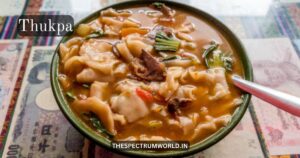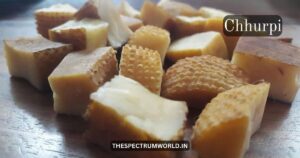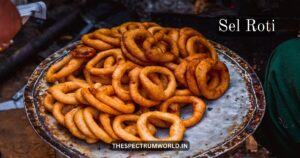11 Famous Delicacies of Sikkim
Sikkim, a small but beautiful state in the northeastern part of India, is known for its rich cultural heritage and delicious cuisine. The state’s unique geography, which includes the Himalayas and the valley of the Teesta River, has influenced the development of its distinct culinary traditions.
Table of Contents
Some of Sikkim’s most famous dishes:
1. Momo:

A traditional Tibetan dish, momos are dumplings filled with meat (usually pork or beef) or vegetables, served with a dipping sauce. They are a staple in the state and can be found in almost every restaurant and street food stall.
2. Thukpa:

A hearty noodle soup made with vegetables, meat (usually pork or beef), and eggs, thukpa is a popular breakfast dish in the state. It’s a comforting and filling meal that’s perfect for the state’s cold climate.
3. Wonton Soup:
Another Tibetan influence, wonton soup is a light and flavorful broth filled with dumplings filled with meat or vegetables.
4. Gyuma:
A traditional dish, gyuma is a type of blood sausage made with pork intestines and spices. It’s usually served with rice or roti (flatbread).
5. Sikkimese Khichuri:
A simple yet satisfying dish made with rice, lentils, and vegetables, khichuri is a staple in many households.
6. Phagshapa:

A unique dish made with pork fat, radish, and chili peppers, phagshapa is a flavorful and spicy curry that’s often served with rice or roti.
7. Khapsay:
A traditional Tibetan noodle dish, khapsay is made with thin noodles, vegetables, and sometimes meat or eggs.
8. Chhurpi:

A dried and aged cheese, chhurpi is a staple in state’s cuisine. It’s often served with rice or roti or used in soups and stews.
9. Gundruk:
Gundruk is a staple in many households, a fermented green leafy vegetable soup. It’s a nutritious and flavorful dish that’s rich in vitamins and minerals.
10. Sel Roti:

A sweet, deep-fried doughnut made with rice flour and sugar, sel roti is a popular snack in the state.
11. Sha Phaley:
A Tibetan-inspired dish, Sha Phaley is a type of fried meat pie often served with momos or thukpa.
Some of Sikkim’s most famous beverages:
1. Chang:

A traditional Tibetan beer made from fermented millet or rice, chang is a staple in the state. It’s usually served during special occasions and is an integral part of its culture.
2. Jaand:
A sweet, fermented rice beer, jaand is a popular beverage in Sikkim. It’s usually served during social gatherings and is known for its refreshing taste.
3. Thomba:

A millet-based beer, thomba is a traditional beverage that’s usually served during special occasions.
4. Chhaang:
A type of butter tea, chhaang is a staple in many households. It’s made by mixing black tea with butter, salt, and milk, and is usually served during breakfast or as a snack.
5. Sikkimese Tea:
Sikkim is famous for its tea plantations, and its tea is known for its distinct flavor and aroma. From black tea to green tea, Sikkim’s tea plantations produce a wide range of tea varieties.
6. Kahwa:

A flavored tea made with green tea leaves, cardamom, cinnamon, and ginger, kahwa is a popular beverage in Sikkim. It’s usually served during social gatherings and is known for its refreshing taste.
7. Gurkha Tea:
A strong and flavorful tea made with black tea leaves, gurkha tea is a staple in many households. It’s usually served during breakfast or as a snack.
8. Sikkimese Coffee:
Sikkim is also famous for its coffee plantations, and its coffee is known for its distinct flavor and aroma. From Arabica to Robusta, the coffee plantations produce a wide range of coffee varieties.
9. Bhabji:
A sweet, creamy drink made with yogurt, milk, and sugar, bhabji is a popular beverage in Sikkim. It’s usually served during social gatherings and is known for its refreshing taste.
10. Sharbat:
A sweet, flavored drink made with fruits, flowers, or herbs, sharbat is a popular beverage in Sikkim.
It is a vibrant state in the northeastern part of India, and is a treasure trove of culinary delights. Its unique geography, cultural heritage, and Tibetan influences have shaped its distinct cuisine, which is a perfect blend of spices, flavors, and textures. From the comforting momos and thukpa to the spicy phagshapa and gyuma, Sikkim’s dishes are a reflection of its rich cultural diversity.
The state’s beverages, too, are a testament to its culinary richness. From the traditional chang and jaand to the soothing chhaang and kahwa, Sikkim’s drinks are an integral part of its cultural identity. The state’s tea and coffee plantations also produce some of the finest brews in the country, making it a paradise for tea and coffee lovers.
What sets Sikkim’s cuisine apart is its emphasis on locally sourced ingredients, traditional cooking methods, and community-driven food culture. The state’s cuisine is deeply rooted in its Buddhist heritage, which emphasizes compassion, sustainability, and mindfulness.
As you explore Sikkim’s culinary landscape, you’ll discover a world of flavors, textures, and aromas that will leave you wanting more. Whether you’re a foodie, an adventurer, or simply looking for a cultural experience, Sikkim’s dishes and beverages are sure to delight and inspire you.
Some key takeaways from Sikkim’s cuisine and beverages:
– Emphasis on locally sourced ingredients and traditional cooking methods
– Strong Tibetan and Buddhist influences
– Unique blend of spices, flavors, and textures
– Community-driven food culture
– Famous for its momos, thukpa, phagshapa, gyuma, and other dishes
– Traditional beverages like chang, jaand, and chhaang are an integral part of the culture
– Tea and coffee plantations produce high-quality brews
– Cuisine is deeply rooted in compassion, sustainability, and mindfulness
Overall, the cuisine and beverages are a reflection of its rich cultural heritage, unique geography, and commitment to sustainability. As you explore this culinary paradise, you’ll discover a world of flavors and traditions that will leave you with unforgettable memories.

Additional insights into Sikkim’s cuisine and beverages:
– Use of local ingredients: Sikkim’s cuisine makes extensive use of local ingredients such as fermented soybeans, mushrooms, bamboo shoots, and a variety of leafy greens.
– Influence of Tibetan cuisine: Sikkim’s cuisine has been heavily influenced by Tibetan cuisine, which is reflected in the use of ingredients like tsampa (roasted barley flour) and chhurpi (dried cheese).
– Popular spices: The cuisine makes use of a variety of spices, including cumin, coriander, turmeric, and chilies.
– Use of fermentation: Fermentation is a common technique used in the cuisine, particularly in the preparation of dishes like gundruk (fermented green leafy vegetable soup) and chhurpi.
– Importance of tea: Tea is an integral part of its culture, with chhaang (butter tea) being a staple in many households.
– Festive cuisine: The cuisine plays an important role in its festivals, with dishes like momos and thukpa being served during special occasions.
– Street food: The street food scene is vibrant, with popular dishes like momos, thukpa, and sel roti (sweet, deep-fried doughnuts) being easily available.
– Culinary innovation: The cuisine is constantly evolving, with modern chefs experimenting with new ingredients and techniques while still retaining the state’s culinary heritage.
– Cooking methods: The cuisine employs a range of cooking methods, including steaming, boiling, frying, and roasting.
– Regional variations: The cuisine varies across regions, with the north, south, east, and west having their unique dishes and cooking styles.
– Culinary tourism: The cuisine is an important part of its tourism industry, with many visitors drawn to the state’s unique food culture.
You may also read and learn about 10 Famous Delicacies of Delhi.







One thought on “11 Famous Delicacies of Sikkim”